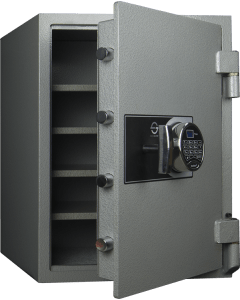
What threats come to mind when you think of getting a drug safe for your pharmacy? The usual unauthorized access, theft, and fire, right? There are many lesser-known threats that people overlook that may be as destructive to the drugs in the safe. Here are 10 uncommon threats to drug safes everyone should know about.
1. Environmental Corrosion
Drug safes are prone to silent sabotage due to installation in places with high humidity or poor ventilation. This is a common issue, especially along the coast, where the salt levels are high, encouraging rust and corrosion. With time, corrosion degrades the structural integrity of the safe to a point where the hinges fail, and it can be pried open. Sometimes, the result affects the electronic locking mechanisms as well.
Solution: Invest in high-quality safes made of corrosion-resistant materials like stainless alloys. Additionally, consider painting the safe if you are along the coast. The paint adds a layer of protection and enhances its durability and functionality.
2. Cybersecurity Weaknesses
Modern drug safes have digital access controls. You can access the safe through Bluetooth; some connect with Wi-Fi to manage, monitor, and audit access. Hackers can easily intercept and gain access if the Wi-Fi network is unsecured or poorly encrypted. The hackers can unlock the safe or remotely disable the security alerts. It is a threat to watch out for, especially if you store controlled substances.
Solution: Reduce vulnerable network points using secure protocols like WPA3 and AES encryption. Follow up with firmware updates and consider using MFA to prevent cyber intrusions.
3. Extreme changes in temperature
If your facility does not have a climate-controlled environment, your safe may be vulnerable to extreme changes in temperature. Extremely high temperatures can degrade medication in the safes, accelerate chemical reactions, and reduce their effectiveness. Insulin, for example, is very heat-sensitive. It can lose potency when exposed to excessive heat.
On the other hand, cold temperatures may make some medications less soluble. In extreme and rare cases, it can cause physical damage like cracking or freezing, affecting dosage accuracy.
Solution: Go for a drug safe with thermal insulation. They will have an internal heating and cooling option to keep the drugs within the required parameters.
4. Human Error
You might have the right safe, but human error remains a threat. Simple mistakes like losing keys, not resetting digital codes, or failing to lock the safe properly threaten security. Sometimes, human error is caused by staff turnover, lack of training, or contentment.
Solution: Get safe with an automated lock system. The drug safe will lock every time after usage. Set a reminder to change the codes after a month or two or anytime a staff member leaves the facility.
5. Falls and Collisions
All safes are designed to be thick and resilient even after impact. Accidents always happen; a hospital, pharmacy, or laboratory is not exempt. A safe can be knocked over by equipment, hospital carts, or items that can fall on it depending on location and organization. Physical impact damages the integrity of the safe. It could lead to broken digital screens, lock mechanisms, or hinges and compromise the lockability.
Solution: Have an expert handle the installation. They can choose an appropriate location for your safe where it will be less likely to be damaged by such impacts—e.g., securing it in a wall.
6. Frequent Use
If the drug safe is in a high-volume environment, e.g., a large pharmacy or hospital, it will need to be accessed multiple times in a day. This is unavoidable, and the constant use could strain the locking mechanism and cause the hinges to wear out faster. Fortunately, high-quality safes are well-built to withstand heavy use; you only need to follow up with proper maintenance.
Solution: Choose a commercial-grade safe that is use-tested to prevent premature aging. Furthermore, go for one with a sturdy locking mechanism and wear-resistant hinges.
7. Electronic Interference
Most safes today have electronic locking mechanisms. This increases security and convenience but also presents electromagnetic field threats. EMI from nearby electronic equipment, such as industry machinery or medical devices, could compromise this. You might get false alerts from the safe, or the locks could malfunction.
Solution: Opt for a safe with anti-EMI technology or Faraday shielding to avoid electronic interference.
Traditional threats to drug safes remain a serious concern. Still, the uncommon threats remain important as they affect the usability and durability of the safe. All drug safes at Safes Australia are built to address these threats. Order one today for maximum protection.





